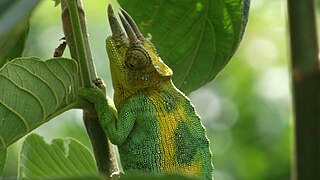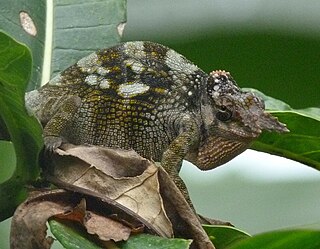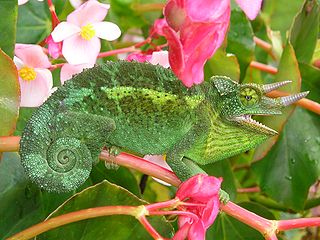
Chameleons or chamaeleons are a distinctive and highly specialized clade of Old World lizards with 200 species described as of June 2015. The members of this family are best known for their distinct range of colours, being capable of colour-shifting camouflage. The large number of species in the family exhibit considerable variability in their capacity to change colour. For some, it is more of a shift of brightness ; for others, a plethora of colour-combinations can be seen.

Chamaeleo is a genus of chameleons in the family Chamaeleonidae. Most species of the genus Chamaeleo are found in sub-Saharan Africa, but a few species are also present in northern Africa, southern Europe, and southern Asia east to India and Sri Lanka.

Achatinella is a tropical genus of colorful land snails in the monotypic Achatinellidae subfamily Achatinellinae.

Trioceros johnstoni, known commonly as Johnston's chameleon, Johnston's three-horned chameleon, or the Ruwenzori three-horned chameleon, is a species of chameleon, a lizard in the family Chamaeleonidae. It is endemic to highlands in the Albertine Rift in central Africa. It reaches up to 30 cm (12 in) in total length and only the adult male has three horns; females are hornless.

Trioceros is a genus of lizards in the family Chamaeleonidae, the chameleons, native to lowlands and highlands in the African mainland, ranging from Ethiopia south to Mozambique and west as far as Ghana. Trioceros was considered a subgenus of the genus Chamaeleo until 2009, when it was elevated to full genus level.

Trioceros melleri, with the common names Meller's chameleon and giant one-horned chameleon, is the largest species of chameleon from the African mainland.

Kinyongia tavetana, the Kilimanjaro two-horned chameleon or Kilimanjaro blade-horned chameleon, is a species of chameleon in the genus Kinyongia. It is native to forests, woodlands, well-wooded gardens and plantations in the highlands of southern Kenya and northern Tanzania. Its type locality is Mount Kilimanjaro, but it is also known from Chyulu Hills and Mount Meru to the Pare Mountains.

The graceful chameleon is a species of chameleon native to sub-Saharan Africa. It is commonly around a foot long. Because of its abundance, it is heavily exploited by the pet trade.

Owen's chameleon, also commonly known as Owen's three-horned chameleon, is a species of lizard in the family Chamaeleonidae. The species is native to forests in central Africa. Named after British naval officer and explorer William Fitzwilliam Owen, it was first described in 1831 by the naturalist John Edward Gray, and is the type species of the genus Trioceros.

Kinyongia boehmei, the Taita blade-horned chameleon, Böhme's two-horned chameleon and Dwarf fischer's chameleon, is species of chameleon, a lizard in the family Chamaeleonidae, found only in the Taita Hills of southeastern Kenya. It is the smallest species in the East African "two-horned chameleon" group and until 2008 it was generally considered a part of K. tavetana.

Kinyongia vosseleri, also known commonly as the Usambara two-horned chameleon and Vosseler's blade-horned chameleon, is an endangered species of lizard in the family Chamaeleonidae. The species is endemic to Tanzania.

The four-horned chameleon is a species of chameleon, a lizard in the family Chamaeleonidae. The species is native to highland areas in western Cameroon and southeastern Nigeria.

Trioceros ellioti, also known commonly as Elliot's chameleon, Elliot's groove-throated chameleon, and the montane side-striped chameleon, is a species of lizard in the family Chamaeleonidae. The species is indigenous to Africa.
Trioceros feae, also known commonly as the Bioko montane chameleon and Fea's chameleon, is a species of lizard in the family Chamaeleonidae. The species is endemic to the island of Bioko.
Trioceros fuelleborni, also known commonly as the flapjack chameleon, the Ngosi Volcano chameleon, and the Poroto three-horned chameleon, is a species of lizard in the family Chamaeleonidae. The species is endemic to Tanzania.

Trioceros goetzei, also known commonly as Goetze's chameleon, Goetze's whistling chameleon, and the Ilolo chameleon, is a species of lizard in the family Chamaeleonidae. The species is native to eastern Africa. There are two recognized subspecies.
Trioceros harennae, also known commonly as the Harenna hornless chameleon, is a species of lizard in the family Chamaeleonidae. The species is endemic to Ethiopia. There are two recognized subspecies.

Trioceros werneri, the Wemer's chameleon or Wemer's three-horned chameleon, is a species of chameleon that is endemic to forests and nearby gardens at altitudes of 1,700–2,600 m (5,600–8,500 ft) in the Eastern Arc Mountains of Tanzania. The adult male has three distinct "horns", whereas the female has no or only a single short horn on the nose. Like many Trioceros species of highlands, the female T. werneri does not lay eggs, but instead gives birth to live young, typically 15–20 at a time.

Chameleon ranching is the action of releasing chameleons into an area with the intent of establishing them and later collecting them to sell for a profit. This type of ranching has existed since the 1970s, but has become more widespread around the early 2000s. It is an example of people intentionally releasing a foreign species.

Chamaeleo intermedius is an extinct species of chameleon from the Miocene of Kenya. It was given its name based on the fact that it shares traits with both species of the genus Chamaeleo and those of Trioceros, which at the time were placed in the same genus. This belief that it was an intermediate form was however rejected by later research.























